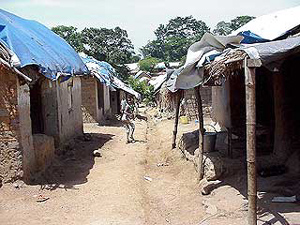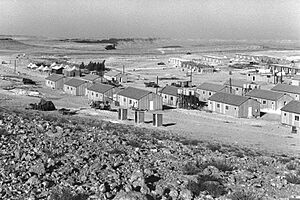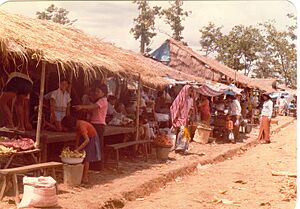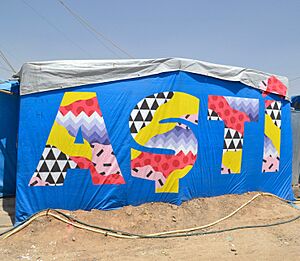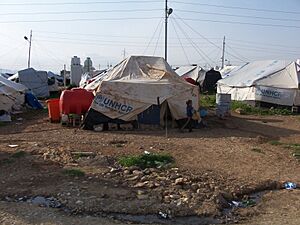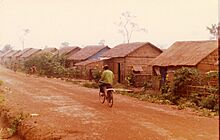Refugee camp facts for kids
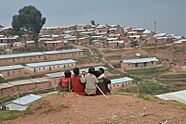

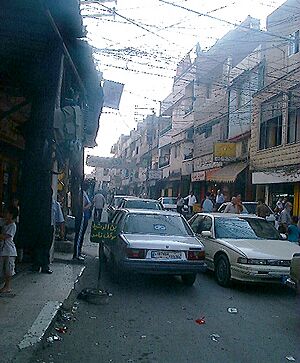
A refugee camp is a temporary settlement built to receive refugees and people in refugee-like situations. Refugee camps usually accommodate displaced people who have fled their home country, but camps are also made for internally displaced people. Usually, refugees seek asylum after they have escaped war in their home countries, but some camps also house environmental and economic migrants. Camps with over a hundred thousand people are common, but as of 2012, the average-sized camp housed around 11,400. They are usually built and run by a government, the United Nations, international organizations (such as the International Committee of the Red Cross), or non-governmental organization. Unofficial refugee camps, such as Idomeni in Greece or the Calais jungle in France, are where refugees are largely left without the support of governments or international organizations.
Refugee camps generally develop in an impromptu fashion with the aim of meeting basic human needs for only a short time. Facilities that make a camp look or feel more permanent are often prohibited by host country governments. If the return of refugees is prevented (often by civil war), a humanitarian crisis can result or continue.
According to UNHCR, most refugees worldwide do not live in refugee camps. At the end of 2015, some 67% of refugees around the world lived in individual, private accommodations. This can be partly explained by the high number of Syrian refugees renting apartments in urban agglomerations across the Middle East. Worldwide, slightly over a quarter (25.4%) of refugees were reported to be living in managed camps. At the end of 2015, about 56% of the total refugee population in rural locations resided in a managed camp, compared to the 2% who resided in individual accommodation. In urban locations, the overwhelming majority (99%) of refugees lived in individual accommodations, compared with less than 1% who lived in a managed camp. A small percentage of refugees also live in collective centres, transit camps, and self-settled camps.
Despite 74% of refugees being in urban areas, the service delivery model of international humanitarian aid agencies remains focused on the establishment and operation of refugee camps.
Contents
Facilities
The average camp size is recommended by UNHCR to be 45 square metres (480 sq ft) per person of the accessible camp area. Within this area, the following facilities can usually be found:
- An administrative headquarters to coordinate services may be inside or outside the actual camp.
- Sleeping accommodations are frequently tents, prefabricated huts, or dwellings constructed of locally available materials. UNHCR recommends a minimum of 3.5 m2 of covered living area per person. Shelters should be at least 2 m apart.
- Gardens attached to the family plot: UNHCR recommends a plot size of 15 m2 per person.
- Hygiene facilities, such as washing areas, latrines, or toilets: UNHCR recommends one shower per 50 persons and one communal latrine per 20 persons. Distance for the latter should be no more than 50 meters from the shelter and not closer than 6 m. Hygiene facilities should be separated by gender.
- Places for water collection: Either water tanks where water is off-loaded from trucks (then filtered and potentially treated with disinfectant chemicals such as chlorine), or water tap stands that are connected to boreholes are needed. UNHCR recommends 20 L of water per person and one tap stand per 80 persons that should be no farther than 200 m away from households.
- Clinics, hospitals and immunization centres: UNHCR recommends one health centre per 20,000 persons and one referral hospital per 200,000 persons.
- Food distribution and therapeutic feeding centres: UNHCR recommends one food distribution centre per 5,000 persons and one feeding centre per 20,000 persons.
- Communication equipment (e.g. radio): Some long-standing camps have their own radio stations.
- Security, including protection from banditry (e.g. barriers and security checkpoints) and peacekeeping troops to prevent armed violence: Police stations may be outside the actual camp.
- Schools and training centres: UNHCR recommends one school per 5,000 persons.
- Markets and shops: UNHCR recommends one marketplace per 20,000 persons.
Schools and markets may be prohibited by the host country's government to discourage refugees from settling permanently in camps. Many refugee camps also have:
- Cemeteries or crematoria
- Locations for solid waste disposal: One 100 L rubbish container should be provided per 50 persons and one refuses pit per 500 persons.
- Reception or transit centre where refugees initially arrive and register before they are allowed into the camp: Reception centres may be outside the camps and closer to the border of the country where refugees enter.
- Churches or other religious centres or places of worship
To understand and monitor an emergency over a period of time, the development and organisation of the camps can be tracked by satellite, and analyzed by GIS.
Arrival
Most new arrivals travel distances up to 500 km on foot. The journey can be dangerous, e.g. wild animals, armed bandits or militias, or landmines. Some refugees are supported by the International Organization for Migration, and some use smugglers. Many new arrivals suffer from acute malnutrition and dehydration. Long queues can develop outside the reception centres, and waiting times of up to two months are possible. People outside the camp are not entitled to official support (but refugees from inside may support them). Some locals sell water or food for excessive prices and make large profits. Not uncommonly, some refugees die while waiting outside the reception centre. They stay in the reception centre until their refugee status is approved and the degree of vulnerability assessed. This usually takes two weeks. They are then taken, usually by bus, to the camp. New arrivals are registered, fingerprinted, and interviewed by the host country's government and the UNHCR. Health and nutrition screenings follow. Those who are extremely malnourished are taken to therapeutic feeding centres and the sick to a hospital. Men and women receive counselling separately from each other to determine their needs. After registration, they are given food rations (until then only high energy biscuits), receive ration cards (the primary marker of refugee status), soap, jerrycans, kitchen sets, sleeping mats, plastic tarpaulins to build shelters (some receive tents or fabricated shelters). Leaders from the refugee community may provide further support to the new arrivals.
Housing and sanitation
Residential plots are allocated (e.g. 10 x 12 m for a family of four to seven people). Shelters may sometimes be built by refugees themselves with locally available materials, but aid agencies may supply materials or even prefabricated housing. Shelters are frequently very close to each other, and frequently, many families share a single dwelling, rendering privacy for couples nonexistent. Camps may have communal unisex pit latrines shared by many households, but aid agencies may provide improved sanitation facilities. Household pit latrines may be built by families themselves. Latrines may not always be kept sufficiently clean and disease-free. In some areas, space for new pits is limited. Each refugee is supposed to receive around 20 L of water a day, but many have to survive on much less than that (some may get as little as 8 L per day). A high number of persons may use a tap stand (against a standard number of one per 80 persons). Drainage of water from bathroom and kitchen use may be poor and garbage may be disposed of in a haphazard fashion. Few or no sanitary facilities may be accessible for people with disabilities. Poor sanitation may lead to outbreaks of infectious disease, and rainy-season flooding of latrine pits increases the risk of infection.
Food rations
The World Food Programme (WFP) provides food rations twice a month: 2,100 calories/person/day. Ideally, it should be:
- 9 oz (260 g) whole grain (maize or sorghum)
- 7 oz (200 g) milled grain (wheat flour)
- 1.5 tablespoons vegetable oil
- 1 teaspoon salt
- 3 tablespoons pulses (beans or lentils)
Diet is insensitive to cultural differences and household needs. WFP is frequently unable to provide all of these staples, thus calories are distributed through whatever commodity is available, e.g. only maize flour. Up to 90% of the refugees sell part or most of their food ration to get cash. Loss of the ration card means no entitlement to food. In 2015, the WFP introduced electronic vouchers.
Economy, work, and income
Research found that if enough aid is provided, the refugees' stimulus effects can boost the host countries' economies. The UN High Commissioner for Refugees (UNHCR) has a policy of helping refugees work and be productive, using their existing skills to meet their own needs and needs of the host country, too:
Ensure the right of refugees to access work and other livelihood opportunities as they are available for nationals... Match programme interventions with corresponding levels of livelihood capacity (existing livelihood assets such as skills and past work experience) and needs identified in the refugee population, and the demands of the market... Assist refugees in becoming self-reliant. Cash / food / rental assistance delivered through humanitarian agencies should be short-term and conditional and gradually lead to self-reliance activities as part of longer-term development... Convene internal and external stakeholders around the results of livelihood assessments to jointly identify livelihood support opportunities.
Refugee-hosting countries, though, do not usually follow this policy and instead do not allow refugees to work legally. In many countries, the only option is either to work for a small incentive (with NGOs based in the camp) or to work illegally with no rights and often bad conditions. In some camps, refugees set up their own businesses. Some refugees even became rich with that. Those without a job or without relatives and friends who send remittances, need to sell parts of their food rations to get cash. As support does not usually provide cash, effective demand may not be created
The main markets of bigger camps usually offer electronics, groceries, hardware, medicine, food, clothing, cosmetics, and services such as prepared food (restaurants, coffee–tea shops), laundry, internet and computer access, banking, electronic repairs and maintenance, and education. Some traders specialize in buying food rations from refugees in small quantities and selling them in large quantities to merchants outside the camp. Many refugees buy in small quantities because they do not have enough money to buy normal sizes, i.e. the goods are put in smaller packages and sold for a higher price. Payment mechanisms used in refugee camps include cash aid/vouchers, in-kind payments (such as voluntary work), and community-based saving and lending.
Investment by outside private sector organizations in community-based energy solutions such as diesel generators, solar kiosks and biogas digesters has been identified as a way to promote community economic development and employment.
Camp structure
So, to UNHCR vocabulary a refugee camp consists of settlements, sectors, blocks, communities, and families. Sixteen families make up a community, sixteen communities make up a block, four blocks make up a sector, and four sectors are called a settlement. A large camp may consist of several settlements. Each block elects a community leader to represent the block. Settlements and markets in bigger camps are often arranged according to the nationalities, ethnicities, tribes, and clans of their inhabitants, such as at Dadaab and Kakuma.
Democracy and justice
In those camps where elections are held, elected refugee community leaders are the contact point within the community for both community members and aid agencies. They mediate and negotiate to resolve problems and liaise with refugees, UNHCR, and other aid agencies. Refugees are expected to convey their concerns, messages, or reports of crimes, etc. through their community leaders. Therefore, community leaders are considered to be part of the disciplinary machinery and many refugees mistrust them. There are allegations of aid agencies bribing them. Community leaders can decide what a crime is and thus, whether it is reported to the police or other agencies. They can use their position to marginalize some refugees from minority groups. In Kakuma and Dadaab Refugee Camps in Kenya, Somali refugees have been allowed to establish their own 'court' system which is funded by charities. Elected community leaders and the elders of the communities provide an informal kind of jurisdiction in refugee camps. They preside over these courts and are allowed to pocket the fines they impose. Refugees are left without legal remedies against abuses and cannot appeal against their own 'courts'.
Security
Security in a refugee camp is usually the responsibility of the host country and is provided by the military or local police. The UNHCR only provides refugees with legal protection, not physical protection. However, local police or the legal system of the host countries may not take responsibility for crimes that occur within camps. In many camps, refugees create their own patrolling systems as police protection is insufficient. Most camps are enclosed with barbed wire fences. This is not only for the protection of the refugees, but also to prevent refugees from moving freely or interacting with local people.
Refugee camps may sometimes serve as headquarters for the recruitment, support and training of guerrilla organizations engaged in fighting in the refugees' area of origin; such organizations often use humanitarian aid to supply their troops. Cambodian refugee camps in Thailand and Rwandan refugee camps in Zaire supported armed groups until their destruction by military forces.
Refugee camps are also places where terror attacks, bombings, militia attacks, stabbings and shootings take place and abductions of aid workers are not unheard of. The police can also play a role in attacks on refugees.
Freedom of movement
Once admitted to a camp, refugees usually do not have the freedom to move about the country but are required to obtain Movement Passes from the UNHCR and the host country's government. Yet informally many refugees are mobile and travel between cities and the camps, or otherwise make use of networks or technology in maintaining these links. Due to widespread corruption in public service, there is a grey area that creates space for refugees to manoeuvre. Many refugees in the camps, given the opportunity, try to make their way to cities. Some refugee elites even rotate between the camp and the city or rotate periods in the camp with periods elsewhere in the country in family networks, sometimes with another relative in a Western country that contributes financially. Refugee camps may serve as a safety net for people who go to cities or who attempt to return to their countries of origin. Some refugees marry nationals so that they can bypass the police rules regarding movements out of the camps. It is a lucrative side-business for many police officers working the area around the camps to have a lot of unofficial roadblocks and to target refugees travelling outside the camps who must pay bribes to avoid deportation.
Duration and durable solutions
Although camps are intended to be a temporary solution, some of them exist for decades. Some Palestinian refugee camps have existed since 1948, camps for Eritreans in Sudan (such as the Shagarab camp) have existed since 1968, the Sahrawi refugee camps in Algeria has existed since 1975, camps for Burmese in Thailand (such as the Mae La refugee camp) have existed since 1986, Buduburam in Ghana since 1990, or Dadaab and Kakuma in Kenya since 1991 and 1992, respectively. In fact, over half of the refugees as of the end of 2017 are in "protracted refugee situations", defined as situations where at least 25,000 people from a particular country are refugees in another particular country for five or more years (though this might not be representative of refugees who are specifically in camps). The longer a camp exist the lower tends to be the annual international funding and the bigger the implications for human rights. Some camps grow into permanent settlements and even merge with nearby older communities, such as Ain al-Hilweh, Lebanon and Deir al-Balah, Palestine.
People may stay in these camps, receiving emergency food and medical aid, for many years and possibly even for their whole life. To prevent this the UNHCR promotes three alternatives to that:
- Once it is safe for them to return to their home countries the refugees can use voluntary return programmes.
- In some cases, refugees may be integrated and naturalised by the country they fled to.
- In some cases, often after several years, refugees may get the offer to be resettled in "third countries". Globally, about 17 countries (Australia, Brazil, Burkina Faso, Canada, Chile, Denmark, Finland, Iceland, Ireland, Mexico, the Netherlands, New Zealand, Norway, Sweden, the United Kingdom, and the United States) regularly accept "quota refugees" from refugee camps. The UNHCR works in partnership with these countries and resettlement programmes, such as the Gateway Protection Programme, that support refugees after arrival in the new countries. In recent years, most quota refugees have come from Afghanistan, Iran, Iraq, Liberia, Somalia, Sudan, Syria, and the former Yugoslavia which have been disrupted by wars and revolutions.
Notable refugee camps
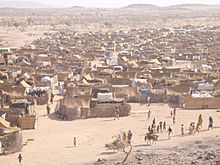
The largest refugee settlements in the world are in the eastern Sahel region of Africa. For many years the Dadaab complex was the largest until it was surpassed by Bidi Bidi in 2017. Bidi Bidi was in turn surpassed by Bangladesh's Kutupalong refugee camp in 2018.
Africa
- A number of camps in the south of Chad – such as Dosseye, Kobitey, Mbitoye, Danamadja, Sido, Doyaba and Djako – host approximately 113,000 refugees from Central African Republic.
- Ali Addeh (or Ali Adde) and Holhol camps in Djibouti host 23,000 refugees, who are mainly from Somalia, but also Ethiopians and Eritreans.
- Benaco and Ngara in Tanzania.
- Buduburam refugee camp in Ghana, home to more than 12,000 Liberians (opened 1990)
- Bwagiriza and Gatumba refugee camps in Burundi host refugees from the DRC.
- By 2013 there were four camps in Maban County, South Sudan, hosting refugees and internally displaced people. Yusuf Batil camp was home to 37,000 refugees, Doro camp to 44,000, Jamam camp to 20,000 and Gendrassa camp to 10,000. These population numbers are subject to fluctuation during the ongoing violence in the country.
- Cameroon hosted more than 240,000 UNHCR registered refugees in 2014, mainly from the Central African Republic: Minawao refugee camp in the north and Gado Badzere, Borgop, Ngam, Timangolo, Mbilé and Lolo refugee camps in the east of Cameroon.
- Choucha camp in Tunisia hosted nearly 20,000 refugees from 13 countries who fled from Libya in 2011. Half of them are sub-Saharan African and Arab refugees and the other half are Bangladeshis who had been working in Libya. 3,000 refugees remained in the camp in 2012, and 1,300 in 2013 and its closure is planned.
- Comè in Benin hosted Togolese refugees until it was closed in 2006.
- Dadaab refugee camps (Ifo, Ifo II, Dagahaley, Hagadera, and Kambioos) in North Eastern Kenya, established in 1991 and now hosting more than 330,000 refugees from Somalia.
- Dzaleka camp in the Dowa District of Malawi is home to 34,000 refugees from Burundi, the DRC and Rwanda.
- Hart Sheik in Ethiopia hosted more than 250,000 mostly refugees from Somalia between 1988 and 2004.
- Itang camp in Ethiopia hosted 182,000 refugees from South Sudan and was the world's largest refugee camp for some time during the 1990s.
- Jomvu, Hatimy and Swaleh Nguru camps near Mombasa, Kenya, were closed in 1997. Refugees, mainly displaced people from Somalia, were either forced to relocate to Kakuma, repatriated or remunerated to voluntarily relocate into unsafe areas in Somalia. Other closed camps in the area include Liboi, Oda, Walda, Thika, Utange and Marafa.
- Kakuma refugee camp in Kenya was opened in 1991. In 2014, it was the third largest refugee camp worldwide. As of June 2015, Kakuma hosts 185,000 people, mostly migrants from the civil war in South Sudan.
- Kala, Meheba and Mwange camps in the northwest of Zambia host refugees from Angola and DRC.
- Lainé and Kouankan (I & II) camps in Guinea hosted nearly 29,300 refugees mostly from Liberia, Sierra Leone, and Côte d'Ivoire. The number reduced to 15,000 in 2009.
- Lazaret in Niger was the largest camp in the Sahel during the extreme drought of 1973–1975 and mainly hosted Tuareg people.
- Lusenda refugee camp in the Democratic Republic of the Congo houses Burundian refugees from across the border.
- M'Bera camp in southeastern Mauritania hosts 50,000 Malian refugees.
- Mentao camp in Burkina Faso hosts 13,000 Malian refugees.
- Nyarugusu refugee camp in Tanzania opened in 1997 and initially hosted 60.000 refugees from the DRC. Due to the recent conflicts in Burundi, it also hosts 90.000 refugees from Burundi. In 2014 it was the 9th largest refugee camp. However, since the conflict in Burundi it is considered one of the world's biggest and most overcrowded camps.
- Osire camp in central Namibia was established in 1992 to accommodate refugees from Angola, Burundi, the DRC, Rwanda and Somalia. It had 20,000 inhabitants in 1998 and only 3,000 in 2014.
- PTP camp near Zwedru, Bahn camp and Little Wlebo camp in eastern Liberia is home to 12,000 refugees from Ivory Coast.
- Ras Ajdir camp, close to the Tunisian border in Libya, was opened in 2011 and is housing between 20,000 and 30,000 Libyan refugees.
- Sahrawi refugee camps near Tindouf, South Western Algeria, were opened circa 1976 and are called Laayoune, Smara, Awserd, February 27, Rabouni, Daira of Bojador and Dakhla.
- There are 12 camps in the east of Chad hosting approximately 250,000 Sudanese refugees from the Darfur region in Sudan. These camps are in Breidjing, Oure Cassoni, Mile, Treguine, Iridimi, Touloum, Kounoungou, Goz Amer, Farchana, Am Nabak, Gaga and Djabal. Some of these camps appear in the documentary Google Darfur.
- There are 12 camps, such as Shagarab and Wad Sharifey, in eastern Sudan. They host around 66,000 mostly Eritrean refugees, the first of whom arrived in 1968.
- There are a number of camps close to Dolo Odo in southern Ethiopia, hosting refugees from Somalia. In 2014 the Dolo Odo camps (Melkadida, Bokolmanyo, Buramino, Kobe Camp, Fugnido, Hilaweyn and Adiharush) were considered to be the second largest.
- There are a number of camps in Rwanda that host 85,000 refugees from the DRC: Gihembe, Kigeme, Kiziba, Mugombwa and Nyabiheke camps.
- There are a rapidly growing number of camps in Uganda, such as Nakivale, Kayaka II, Kyangwali and Rwamwanja. They host 170,000 refugees from South Sudan and the Democratic Republic Of Congo.
- Tongogara Refugee Camp in Zimbabwe was established for Mozambican refugees in 1984 and housed 58,000 of them in 1994.
Asia
- Ban Mai Nai Soi refugee camp in Burma hosted 19,512 Karenni people in 2008.
- Champtala is a camp in Afghanistan that hosts Afghan refugees who returned from Pakistan.
- Galang Refugee Camp in Indonesia accommodated Indochinese refugees between 1979 and 1996.
- Mae La refugee camp in Thailand hosted around 40,000 Burmese in 2020, most whom were Karen ethnicity. It is the largest of a series of refugee camps coordinated by the Karen Refugee Committee in Thailand.
- Niatak and Torbat-e Jam camps in Iran host Afghan refugees.
- Philippine Refugee Processing Center for Vietnamese, Laotian, and Cambodian refugees fleeing wars in Indochina.
- There are a number of camps in Nepal, such as the three Beldangi refugee camps, Goldhap, Khudunabari, Sanischare and Timai hosting Bhutanese refugees. They are Lhotshampas who were forced to flee from Bhutan to Nepal.
- There are a number of camps in Pakistan that host Afghan refugees, such as Panian, Nasir Bagh, Old Shamshatoo, Old Akora, Gamkol, Barakai, Badaber, Girdi Jungle, Azakhel and Saranan. Jelazee camp, which also hosted Afghan refugees was closed in 2001, because of security concerns.
- There are a number of camps, such as Puzhal, for Sri Lankan Tamils, established in Tamil Nadu in India in 1983, with over 110,000 refugees by 1998.
- There are two camps, Nayapara and Kutupalong, in south-eastern Bangladesh hosting 30,000 registered Rohingya people who fled from Myanmar. It is estimated that 200,000 undocumented Rohingya refugees are living outside the camps with little access to humanitarian assistance. Kutupalong camp may become one of the world's largest refugee camps as there are plans to extend it, so up to 800,000 Rohingya refugees can be housed.
- There were a number of camps on the Thai-Cambodian border in Thailand which hosted Khmer people and Vietnamese between 1979 and 1993 (see Indochina refugee crisis and Cambodian humanitarian crisis), such as Nong Samet, Nong Chan, Sa Kaeo, Site Two, and Khao-I-Dang. There were also camps in the Thai-Laotian border region, hosting Hmong people and Laotians, such as Ban Vinai and Nong Khai. These camps existed between 1975, and final closure in the 1990s.
- Whitehead Camp, Hong Kong, considered the "world's largest prison" in the early 1990s
Middle East
- Al Kharaz in Yemen hosts 14,000 refugees from Somalia who crossed the Gulf of Aden.
- Al-Mazraq camps (1-3) host around 24,000 internally displaced persons in Yemen.
- Camps for Syrian refugees in Iraqi Kurdistan, including Domiz in Dohuk Governorate, Arbat in Sulaymaniyah, and Qushtapa, Basirma, Gawilan, Kawergosk and Darashakran in Erbil Governorate. (see also Syrian refugee camps in Iraqi Kurdistan)
- Camps for Syrian refugees in Turkey, such as Urfa, Kilis Oncupinar, Gaziantep and those in the Hatay Province that were opened in 2011 (see also Syrian refugee camps in Turkey).
- Immigrant camps (Israel) (1947–1950) and Ma'abarot transition camps (1950–1963) to accommodate Jewish refugees and immigrants in Israel.
- Mrajeeb Al Fhood refugee camp in Jordan, hosting 4,200 and Azraq camp, hosting 26,000 Syrian refugees.
- Palestinian refugee camps were opened between 1948 and 1968. The 59 camps are recognized by the UNRWA and host 1.5 million refugees in Jordan, Lebanon, Syria, the West Bank and the Gaza Strip. These camps contain the world's largest and oldest refugee population. Yarmouk camp, just outside Damascus, is one of them and was once home to half a million Palestinian refugees (about 18,000 in 2015). It has been besieged by Bashar al-Assad's regime in 2012 and came again under attack by the Islamic State group in 2015.
- There are camps for displaced Syrians within Syria such as Qah or the Olive Tree Camp.
- Three camps received Palestinian refugees from Iraq: Al Tanf, Al Hol and Al Waleed. There are around 2,000 refugees in Al Hol and in Al Waleed camp, which is on the Iraqi side of the border. Al Tanf, which was on the Syrian side and hosted 1,600 Palestinians, was closed in 2010. An effort was made to close Al Tanf because the refugees' freedom of movement was severely restricted and the desert environment, with its sandstorms and extreme temperatures, was too harsh. Most of the refugees who lived there were resettled to third countries.
- Zaatari refugee camp in Jordan, hosting 144,000 Syrian refugees as of July 2013, although the population in November 2013 had dropped to around 112,000 as the Syrian civil war continues.
Europe
- Cyprus internment camps (1946–1949) to accommodate Jewish refugees and Holocaust survivors
- Ħal Far, Malta, for African immigrants.
- Lampedusa immigrant reception center for refugees, asylum seekers and other immigrants on the Italian island of Lampedusa.
- Moria, Oreokastro, Katsikas, Idomeni, and other camps on the Greek islands of Lesbos, Samos, and Chios have rapidly filled (up to 3–4 times more than their official capacity) with migrants fleeing violence in the Middle East and Africa. Since 2015, refugees fleeing conflict such as the Syrian Civil War have attempted to enter Europe but are often stopped in Greece, where they spend, on average, 8 months to a year in camps. Some camps have been destroyed or evacuated, including the evacuation of 4,000 residents from a camp on the island of Lesbos (capacity 1,500) from a tent fire that destroyed more than half the camp.
- Bagnoli camp in Naples, Italy, housed up to 10,000 refugees from Eastern Europe between 1946 and 1951.
- Čardak was a camp in Serbia, for Serbs who fled from Croatia and Bosnia.
- Friedland refugee camp in Germany hosted refugees who fled from the former eastern territories of Germany at the end of World War II, between 1944 and 1950. Between 1950 and 1987 it was a transit centre for East German (GDR) citizens who wanted to flee to West Germany (FRG).
- International Refugee Organization camp at Lesum, near Bremen, Germany.
- Kjesäter in Sweden was a refugee camp and transit centre for Norwegian refugees fleeing Nazi persecution during World War II.
- Kløvermarken in Denmark was a refugee camp that hosted 19,000 German refugees between 1945 and 1949.
- La Linière and Basroch camps in Grande-Synthe, on the outskirts of Dunkirk, northern France (destroyed by fire on April 11, 2017).
- Sangatte camp and the Calais jungle in northern France.
- The Oksbøl Refugee Camp was the largest camp for German Refugees in Denmark after World War II.
- There are two Emergency Transit Centres for refugees in Europe. One in Timișoara, Romania, and one in Humenné, Slovakia. They can provide a temporary safe haven for refugees who needed to be evacuated immediately from life-threatening situations before being resettled.
- Traiskirchen camp in eastern Austria hosts refugees that come to Europe as part of the European migrant crisis.
- Vrela Ribnička refugee camp in Montenegro was built in 1994 and houses refugees of Bosnian origin who were displaced during the Yugoslav Wars.
Refugee camps by country and population
| Country | Camp | 2006 | 2007 | 2008 | 2009 | 2010 | 2011 | 2012 | 2013 | 2014 |
|---|---|---|---|---|---|---|---|---|---|---|
| Chad | Am Nabak | 16,504 | 16,701 | 16,696 | 17,402 | 18,087 | 20,395 | 23,611 | 24,513 | 25,553 |
| Chad | Amboko | 12,062 | 12,002 | 12,057 | 11,671 | 11,111 | 11,627 | 11,297 | 10,719 | 11,819 |
| Kenya | Dagahaley, Dadaab | 39,526 | 39,626 | 65,581 | 93,179 | 93,470 | 122,214 | 121,127 | 104,565 | 88,486 |
| Chad | Djabal | 15,162 | 15,602 | 17,153 | 15,693 | 17,200 | 18,083 | 18,890 | 19,635 | 20,809 |
| Yemen | Al Kharaz | 9,298 | 9,491 | 11,394 | 16,466 | 14,100 | 16,904 | 19,047 | 16,816 | 16,500 |
| Chad | Breidjing | 28,932 | 30,077 | 32,669 | 32,559 | 34,465 | 35,938 | 37,494 | 39,797 | 41,146 |
| Malawi | Dzaleka | 4,950 | 8,690 | 9,425 | 10,275 | 12,819 | 16,853 | 16,664 | 16,935 | 5,874 |
| Chad | Farchana | 18,947 | 19,815 | 21,183 | 20,915 | 21,983 | 23,323 | 24,419 | 26,292 | 27,548 |
| Kenya | Hagadera, Dadaab | 59,185 | 70,412 | 90,403 | 83,518 | 101,506 | 137,528 | 139,483 | 114,729 | 106,968 |
| Sudan | Girba | 8,996 | 9,081 | 5,120 | 5,645 | 5,592 | 5,570 | 6,252 | 6,295 | 6,306 |
| Chad | Gondje | 12,624 | 12,664 | 12,700 | 11,184 | 9,586 | 10,006 | 11,717 | 11,349 | 12,138 |
| Kenya | Ifo, Dadaab | 54,157 | 61,832 | 79,469 | 79,424 | 97,610 | 118,972 | 98,294 | 99,761 | 83,750 |
| Chad | Iridimi | 17,380 | 18,269 | 19,531 | 18,154 | 18,859 | 21,329 | 21,083 | 21,976 | 22,908 |
| Kenya | Kakuma | 90,457 | 62,497 | 53,068 | 64,791 | 69,822 | 85,862 | 107,205 | 128,540 | 153,959 |
| Sudan | Kilo 26 | 11,423 | 12,690 | 7,133 | 7,610 | 7,608 | 7,634 | 8,310 | 8,303 | 8,391 |
| Chad | Kounoungou | 13,315 | 13,500 | 18,514 | 16,237 | 16,927 | 18,251 | 19,143 | 20,876 | 21,960 |
| Bangladesh | Kutapalong | 10,144 | 10,708 | 11,047 | 11,251 | 11,469 | 11,706 | 12,404 | 12,626 | 13,176 |
| Thailand | Mae La | 46,148 | 38,130 | 32,862 | 30,073 | 29,188 | 27,629 | 26,690 | 25,156 | 46,978 |
| Thailand | Mae La Oon | 14,366 | 13,450 | 13,478 | 13,811 | 11,991 | 10,204 | 9,611 | 8,675 | 12,245 |
| Thailand | Mae Ra Ma Luang | 12,840 | 11,578 | 11,304 | 13,571 | 11,749 | 10,269 | 9,414 | 8,421 | 13,825 |
| Chad | Mile | 15,557 | 16,202 | 17,476 | 14,221 | 17,382 | 18,853 | 19,823 | 20,818 | 21,723 |
| Bangladesh | Nayapara | 16,010 | 16,679 | 17,076 | 17,091 | 17,547 | 17,729 | 18,066 | 18,288 | 19,179 |
| Thailand | Nu Po | 13,131 | 13,377 | 11,113 | 9,800 | 9,262 | 15,982 | 15,715 | 7,927 | 13,372 |
| Tanzania | Nyarugusu | 52,713 | 50,841 | 49,628 | 62,184 | 62,726 | 63,551 | 68,132 | 68,888 | 57,267 |
| Chad | Oure Cassoni | 26,786 | 28,035 | 28,430 | 31,189 | 32,206 | 36,168 | 33,267 | 35,415 | 36,466 |
| Ethiopia | Shimelba | 13,043 | 16,057 | 10,648 | 10,135 | 9,187 | 8,295 | 6,033 | 5,885 | 6,106 |
| India | Tamil Nadu | 69,609 | 72,934 | 73,286 | 72,883 | 69,998 | 68,152 | 67,165 | 65,674 | 65,057 |
| Chad | Touloum | 22,358 | 23,131 | 24,935 | 26,532 | 24,500 | 27,588 | 27,940 | 28,501 | 29,683 |
| Chad | Treguine | 14,921 | 15,718 | 17,260 | 17,000 | 17,820 | 19,099 | 19,957 | 20,990 | 21,801 |
| Sudan | Um Gargur | 9,845 | 10,104 | 8,180 | 8,715 | 8,641 | 8,550 | 8,947 | 10,172 | 10,269 |
| Thailand | Um Pium | 19,464 | 19,397 | 14,051 | 12,494 | 11,742 | 11,017 | 10,581 | 9,816 | 16,109 |
| Sudan | Wad Sherife | 33,371 | 36,429 | 13,636 | 15,626 | 15,819 | 15,481 | 15,472 | 15,318 | 15,357 |
| Ethiopia | Fugnido | 27,175 | 18,726 | – | 20,202 | 21,770 | 22,692 | 34,247 | 42,044 | 53,218 |
| Chad | Gaga | 12,402 | 17,708 | 20,677 | 19,043 | 19,888 | 21,474 | 22,266 | 23,236 | 24,591 |
| Pakistan | Gamkol | – | 37,462 | 33,499 | 33,033 | 35,169 | 32,830 | 31,701 | 31,326 | 30,241 |
| Pakistan | Gandaf | – | 13,609 | 12,659 | 12,497 | 12,731 | 13,346 | 12,632 | 12,508 | 12,068 |
| South Sudan | Gendressa | – | – | – | – | – | – | 14,758 | 17,289 | 17,975 |
| Rwanda | Gihembe | 17,732 | 18,081 | 19,027 | 19,407 | 19,853 | 19,827 | 14,006 | – | 14,735 |
| Liberia | Bahn | – | – | – | – | – | 5,021 | 8,851 | 8,412 | 5,257 |
| Ethiopia | Bambasi | – | – | – | – | – | – | 12,199 | 13,354 | 14,279 |
| Pakistan | Barakai | – | 30,266 | 28,851 | 28,597 | 32,077 | 28,093 | 26,739 | 25,909 | 24,786 |
| Ethiopia | Tongo | – | – | – | – | – | 9,605 | 9,518 | 10,399 | 11,075 |
| Chad | Yaroungou | 15,260 | 13,352 | 16,573 | 11,925 | 10,544 | 10,916 | 11,594 | – | – |
| South Sudan | Yusuf Batil | – | – | – | – | – | – | 36,754 | 39,033 | 40,240 |
| Jordan | Zaatari | – | – | – | – | – | – | – | 145,209 | 84,773 |
| Pakistan | Thall | – | 17,266 | 15,602 | 15,269 | 15,419 | 13,468 | 12,976 | 12,847 | 12,247 |
| Thailand | Tham Hin | 7,767 | 6,007 | 5,078 | – | 4,282 | 7,150 | 7,242 | – | 7,406 |
| Nepal | Timai | 10,413 | 10,421 | 9,935 | 8,553 | 7,058 | – | – | – | – |
| Pakistan | Timer | – | 13,919 | 12,080 | 11,839 | 11,764 | 11,161 | 8,665 | 8,603 | 8,690 |
| Algeria | Tindouf | 90,000 | 90,000 | 90,000 | 90,000 | 90,000 | 90,000 | 90,000 | 90,000 | 90,000 |
| Pakistan | Old Akora | – | 41,647 | 37,757 | 37,019 | 42,872 | 37,736 | 36,693 | 36,384 | 34,789 |
| Pakistan | Old Shamshatoo | – | 66,556 | 58,773 | 58,804 | 61,205 | 54,502 | 53,573 | 52,835 | 48,268 |
| Namibia | Osire | 6,486 | 7,730 | 8,122 | 8,506 | – | – | – | – | – |
| Uganda | Pader | – | – | 196,000 | 90,000 | 38,550 | 6,677 | – | – | – |
| Pakistan | Padhana | – | 10,564 | 10,403 | 10,380 | 11,393 | 10,075 | 9,892 | 9,775 | 9,362 |
| Pakistan | Panian | – | 65,033 | 62,293 | 61,822 | 67,332 | 58,819 | 56,820 | 56,295 | 53,816 |
| Pakistan | Pir Alizai | – | 16,563 | 14,710 | 13,802 | 15,157 | 10,243 | 9,771 | 9,204 | 7,681 |
| Nepal | Sanischare | 21,285 | 21,386 | 20,128 | 16,745 | 13,649 | 10,173 | 9,212 | 6,599 | – |
| Pakistan | Saranan | – | 24,625 | 24,272 | 24,119 | 26,786 | 21,927 | 21,218 | 20,744 | 18,248 |
| Sudan | Shagarab | 21,999 | 22,706 | 14,990 | 16,562 | 24,104 | 27,809 | 37,428 | 34,147 | 34,039 |
| Ethiopia | Sheder | – | – | 6,567 | 7,964 | 10,458 | 11,326 | 11,882 | 11,248 | 12,263 |
| Ethiopia | Sherkole | 13,958 | 8,989 | – | – | – | 8,962 | 7,527 | 9,737 | 10,171 |
| Pakistan | Surkhab | – | 12,225 | 11,877 | 11,789 | 12,304 | 7,422 | 7,214 | 7,012 | 5,764 |
| Burkina Faso | Mentao | – | – | – | – | – | – | 6,905 | 11,907 | 10,953 |
| Tanzania | Mtabila | – | 90,680 | 45,247 | 36,009 | 36,789 | 37,554 | – | – | – |
| Pakistan | Munda | – | 13,274 | 11,386 | 11,225 | 12,728 | 10,341 | 10,100 | 9,941 | 9,388 |
| Burundi | Musasa | – | 6,764 | 5,984 | 6,572 | 6,153 | 6,330 | 6,500 | 6,829 | 7,001 |
| Zambia | Mwange | 21,179 | 17,911 | 14,429 | 5,820 | – | – | – | – | – |
| Uganda | Nakivale | 25,692 | 33,176 | 42,113 | 52,249 | – | – | 64,373 | – | 66,691 |
| Pakistan | New Durrani | – | – | – | – | 10,458 | 14,397 | 12,438 | 14,978 | – |
| Pakistan | Oblan | – | 11,564 | 9,624 | 9,560 | 10,065 | 9,474 | 9,331 | 9,294 | 9,015 |
| Liberia | PTP | – | – | – | – | – | – | 9,353 | 12,734 | 15,300 |
| Uganda | Rhino Camp | 18,493 | 14,328 | 5,582 | – | – | – | 4,266 | – | 18,762 |
| Uganda | Rwamwanja | – | – | – | – | – | – | 29,797 | – | 52,489 |
| Liberia | Little Wlebbo | – | – | – | – | – | – | 8,399 | 10,009 | 8,481 |
| Tanzania | Lugufu | 75,254 | 45,308 | 28,995 | – | – | – | – | – | – |
| Tanzania | Lukole | 39,685 | 25,490 | – | – | – | – | – | – | – |
| Thailand | Mai Nai Soi | – | 19,103 | 19,311 | – | 12,252 | 12,244 | 11,730 | 9,725 | 12,414 |
| Ethiopia | Mai Ayni | – | – | – | 15,762 | 12,255 | 14,432 | 15,715 | 18,207 | 17,808 |
| Iraq | Makhmour | 11,900 | 10,728 | 10,912 | – | 11,101 | 10,240 | 10,552 | 10,534 | – |
| Mozambique | Maratane | 5,019 | – | – | – | 6,646 | 9,576 | 7,398 | 7,707 | – |
| Uganda | Masindi | – | – | 55,000 | 55,000 | 20,000 | 6,500 | – | – | – |
| Zambia | Mayukwayukwa | 10,636 | 10,660 | 10,474 | 10,184 | – | – | 10,117 | 11,366 | – |
| Mauritania | M'bera | – | – | – | – | – | – | – | 66,392 | 48,910 |
| Zambia | Meheba | 13,732 | 13,892 | 15,763 | 14,970 | – | – | 17,708 | 17,806 | 8,410 |
| Ethiopia | Melkadida | – | – | – | – | 25,491 | 40,696 | 42,365 | 43,480 | 44,645 |
| Chad | Abgadam | – | – | – | – | – | – | – | 21,914 | 21,571 |
| Ethiopia | Adi Harush | – | – | – | – | 6,923 | 15,982 | 23,562 | 25,801 | 34,090 |
| Uganda | Adjumani | 54,051 | 52,784 | 21,714 | 28,000 | 7,365 | – | 9,279 | 11,986 | 96,926 |
| South Sudan | Ajuong Thok | – | – | – | – | – | – | – | 6,691 | 15,015 |
| Djibouti | Ali Adde | 6,739 | 6,376 | 8,924 | – | 14,333 | 19,500 | 17,354 | 17,523 | 18,208 |
| Uganda | Amuru | – | – | 234,000 | 98,000 | 35,475 | 6,779 | – | – | – |
| Ethiopia | Awbarre / Teferiber | – | 8,581 | 11,045 | 12,293 | 13,120 | 13,426 | 13,331 | 13,752 | 12,965 |
| Pakistan | Azakhel | – | 25,649 | 24,258 | 23,963 | 26,342 | 21,398 | 21,231 | 21,132 | 20,191 |
| Jordan | Azraq | – | – | – | – | – | – | – | – | 11,315 |
| Pakistan | Badaber | – | 36,614 | 30,327 | 30,107 | 31,345 | 28,729 | 26,227 | 25,589 | 23,918 |
| Nepal | Beldangi 1 & 2 | 52,997 | 52,967 | 50,350 | 42,122 | 36,761 | 33,855 | 31,976 | 24,377 | 18,379 |
| Chad | Belome | – | – | – | – | – | – | – | 23,949 | 26,521 |
| Ethiopia | Bokolmanyo | – | – | – | 21,707 | 14,988 | 38,501 | 40,423 | 41,670 | 41,665 |
| Ghana | Buduburam | 36,159 | 26,179 | 14,992 | 11,334 | – | – | – | – | – |
| Ethiopia | Buramino | – | – | – | – | – | – | 35,207 | 40,114 | 39,471 |
| Burundi | Bwagiriza | 2,896 | 4,526 | 6,159 | 10,105 | 9,289 | 9,480 | |||
| Niger | Abala | – | – | – | – | – | – | 11,126 | 12,216 | 12,938 |
| Pakistan | Chakdara | – | 17,420 | 16,427 | 16,069 | 18,752 | 13,354 | 11,242 | 11,184 | 10,704 |
| Kenya | Ifo 2, Dadaab | – | – | – | – | – | 64,945 | 69,269 | 65,693 | 52,310 |
| Kenya | Kambioos, Dadaab | – | – | – | – | – | 10,833 | 18,126 | 20,435 | 21,035 |
| Chad | Dogdore | – | – | – | – | 19,500 | 19,500 | 19,500 | – | – |
| South Sudan | Doro | – | – | – | – | – | 28,709 | – | 47,422 | 50,087 |
| Chad | Dosseye | 2,277 | 6,158 | 8,556 | 9,607 | 9,433 | 9,724 | 9,922 | 15,766 | 21,522 |
| Pakistan | Girdi Jungle | – | 29,783 | 29,717 | 29,716 | 31,642 | 22,740 | 22,340 | 22,065 | 17,376 |
| Nepal | Goldhap | 9,602 | 9,694 | 8,315 | 6,356 | 4,764 | – | – | – | – |
| Burkina Faso | Goudebo | – | – | – | – | – | – | 4,943 | 9,287 | 9,403 |
| Chad | Goz Amer | 19,261 | 20,097 | 21,640 | 21,449 | 24,608 | 25,841 | 27,091 | 30,105 | 31,477 |
| Chad | Goz Beïda | – | – | – | – | 73,000 | 73,000 | 60,500 | – | – |
| Uganda | Gulu | – | – | 156,000 | 44,000 | 9,043 | – | – | – | – |
| Yemen | Al-Mazrak | – | – | – | – | – | 12,075 | 12,308 | 12,416 | – |
| Ethiopia | Hilaweyn | – | – | – | – | – | 25,747 | 30,960 | 37,305 | 38,890 |
| Ethiopia | Hitsats | – | – | – | – | – | – | – | 10,226 | 33,235 |
| Uganda | Impevi | 23,331 | 22,061 | 7,453 | – | – | – | – | – | – |
| Niger | Intikane | – | – | – | – | – | – | – | 11,221 | 12,738 |
| Sri Lanka | Jaffna | – | 10,522 | – | – | 9,108 | 6,436 | – | – | – |
| Pakistan | Jalala | – | 16,160 | 14,115 | 13,854 | 16,094 | 14,042 | 13,421 | 13,278 | 12,968 |
| Ethiopia | Kobe | – | – | – | – | – | 26,033 | 31,656 | 36,488 | 39,214 |
| Pakistan | Koga | – | 10,766 | 10,458 | 9,264 | 9,183 | 9,216 | 8,893 | 8,738 | 8,404 |
| Pakistan | Kot Chandna | – | 15,130 | 15,037 | 15,012 | 17,787 | 15,100 | 14,889 | 14,664 | 13,796 |
| Ethiopia | Kule | – | – | – | – | – | – | – | – | 46,314 |
| Pakistan | Jalozai | – | 83,616 | 32,155 | 30,955 | 100,748 | 32,499 | 57,771 | 22,076 | – |
| Pakistan | Kababian | – | 14,729 | 11,291 | 12,335 | 13,214 | 12,504 | 12,167 | 11,664 | 11,044 |
| Pakistan | Kacha Gari | – | 26,721 | 24,554 | 28,365 | – | – | – | – | – |
| Zambia | Kala | 19,143 | 16,877 | 12,768 | – | – | – | – | – | – |
| South Sudan | Kaya | – | – | – | – | – | – | – | 18,788 | 21,918 |
| Uganda | Kyaka II | 16,410 | 18,229 | 14,750 | 17,442 | – | – | 18,055 | – | 22,616 |
| Ethiopia | Kebribeyah | 16,399 | 16,879 | 16,132 | 16,496 | 16,601 | 16,408 | 16,009 | 15,788 | – |
| Iran | Rafsanjan | 12,715 | – | – | 6,630 | 6,852 | – | – | – | – |
| Pakistan | Khaki | – | 16,267 | 16,010 | 15,933 | 16,221 | 15,768 | 14,939 | 14,698 | 14,101 |
| Nepal | Khudunabari | 13,506 | 13,226 | 13,254 | 12,054 | 11,067 | 9,032 | – | – | – |
| Burundi | Kinama | – | – | 8,447 | 9,369 | 9,480 | 9,759 | 9,796 | ||
| Uganda | Kitgum | – | – | 164,000 | 122,000 | 12,290 | 7,070 | – | – | – |
| Rwanda | Kiziba | 17,978 | 18,130 | 18,323 | 18,693 | 18,888 | 18,919 | 15,927 | – | – |
| Pakistan | Khairābād-Kund | – | 14,674 | 11,686 | 11,669 | 11,839 | 12,921 | 12,961 | – | – |
| Uganda | Kyangwali | 19,132 | 20,109 | 13,434 | 20,606 | – | – | 21,280 | – | 40,023 |
| Guinea | Laine | 11,406 | 5,185 | – | – | 4,187 | – | – | – | – |
| Ethiopia | Leitchour | – | – | – | – | – | – | – | – | 47,711 |
| Botswana | Dukwe | – | – | – | – | – | – | – | – | 2,833 |
Unofficial refugee settlements
Within countries experiencing large refugee in-migrations, citizen volunteers, non-governmental organizations, and refugees themselves have developed short- and long-term alternatives to official refugee camps established by governments or the UNHCR. Informal camps provide physical shelter and direct service provision but also function as a form of political activism. Alternative forms of migrant settlement include squats, occupations and unofficial camps.
Asylum seekers who have been rejected and refugees without access to state services in Amsterdam worked with other migrants to create the "We are here" movement in 2012. The group set up tents on empty land and occupied empty buildings including a church, office spaces, a garage, and a former hospital. The purpose of these occupations was both for physical housing and to create space for political, cultural, and social communities and events.
In Brussels, Belgium, the speed of refugee processing and the lack of shelters in 2015 resulted in a large number of refugees sleeping in the streets. In response, a group of Belgian citizens and a collective of undocumented migrants built an informal camp in the Maximiliaan park in front of the Foreign Office and provided food, shelter, medical care, schooling, and activities such as a mobile cinema. This camp also functioned as a form of protest through its claims to space and visible location in front of government agencies.
The "Jungle" in Calais, France was an unofficial refugee camp, not legally approved by local or national French authorities. Because the camp did not receive support from the state government or international aid agencies, grassroots organizations were developed to manage food, donations, temporary shelters and toilets, and recreational activities within the camp. Most of the volunteers had not previously been involved in refugee aid work and were not professionals in humanitarian aid. Although filling a need for service provision, the volunteer nature of aid in informal camps resulted in a lack of accountability, reports of volunteers taking advantage of refugees, risks of violence towards volunteers, and a lack of capacity to handle complex situations within the camps such as trafficking, exploitation, and violence. However, volunteer work in the Calais Jungle also functioned as a form of civil disobedience, because working within the camp fell within the definition of Article L622-1 of the French Penal Code, known as the "délit de solidarité" ("crime of solidarity"), which made it illegal to assist the "arrival, movement or residence of persons irregularly present on the French territory".
See also
 In Spanish: Campo de refugiados para niños
In Spanish: Campo de refugiados para niños



